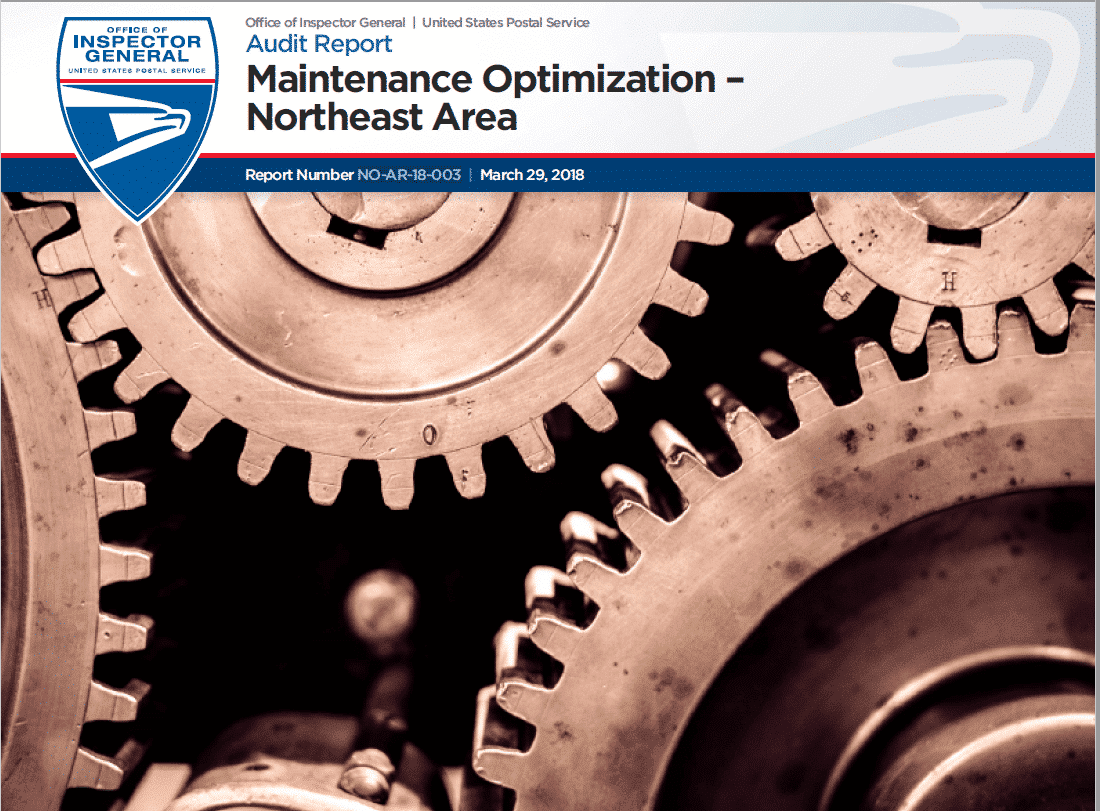
Objective
The objective of our audit was to evaluate the effectiveness of the U.S. Postal Service’s maintenance optimization initiative in the Northeast Area.
The Postal Service’s Five-Year Strategic Plan – Fiscal Year (FY) 2017 to 2021 outlines its maintenance optimization initiative to standardize, upgrade, and realign maintenance operations across field offices efficiently and effectively in order to reduce operating expenses. Savings in Labor Distribution Code (LDC) 37 – Building and Plant Equipment and LDC 38 – Building Services were included in the Postal Service’s initiative. The FY 2017 planned national savings for the initiative were $57 million in LDC 37 and $40 million in LDC 38. The achieved savings were $47 million and $43 million, respectively.
Headquarters management established and tracked maintenance optimization planned savings at the national level only and not at the seven Postal Service areas. To determine area performance, we obtained FY 2017 actual versus plan workhours for LDCs 37 and 38, respectively.
What the OIG Found
We found the Northeast Area achieved the initiative savings for LDC 38 in FY 2017, but not for LDC 37. The Northeast Area was able to achieve LDC 38 savings by implementing improvements in the cleaning process for facilities and by updating cleaning equipment. These changes included the use of better cleaning supplies, a two-bucket system for cleaning floors, and backpack vacuum cleaners.
The Northeast Area had the lowest LDC 37 workhour performance to plan for the seven Postal Service areas in FY 2017. They used over 78,000 more workhours than planned, or about 12 percent.
However, in comparing FY 2016 to FY 2017, the Northeast Area achieved an LDC 37 workhour reduction of about 181,000 hours, or about 20 percent, and a reduction of 75 employees, or about 15 percent. They also reduced the use of penalty overtime from about 3 percent in FY 2016 to about 2 percent in FY 2017. Although regular overtime increased from about 13 percent to about 14 percent in the same time period.
We selected the four lowest performing mail processing facilities in the Northeast Area based on those that exceeded the FY 2017 workhour plan the most for LDC 37. The mail processing facilities we identified and visited were the Springfield, MA, Network Distribution Center (NDC) and the Brockton, MA, Mid-Island, NY, and Providence, RI, Processing and Distribution Centers (P&DCs). We also selected the two-highest performing mail processing facilities in the Northeast Area based on those that used fewer FY 2017 workhours than planned for LDC 37. The mail processing facilities we identified and visited were the Albany, NY, and Middlesex-Essex, MA, P&DCs. We conducted site visits in October and November 2017.
We found local managers did not fully understand or were not aware of the maintenance optimization initiative, its goals, and how to achieve the associated savings. Specifically, two plant managers were not aware of the initiative and the remaining four were aware of the initiative, but could not define the goals. This occurred because of inadequate communication between Headquarters Network Operations, the Northeast Area, and the Northeast Area mail processing facilities. Without adequate knowledge of the maintenance optimization initiative, local management cannot effectively achieve the planned savings.
Additionally, we found that Human Resources assigned employees to LDC 37 when they should have been assigned to LDC 36 based on the work they performed. For example, at the two high-performing mail processing facilities we visited, we found no employees incorrectly assigned to LDC 37; however, at the low-performing Brockton and Providence P&DCs we found five of 11 and seven of 22 employees, respectively, should not have been assigned to LDC 37. Springfield and Mid-Island managers had already corrected employee assignments. When employees are not assigned to the correct LDC, the Postal Service cannot adequately determine if the program is a success.
Finally, at four of the six mail processing facilities we visited (two high-performing and two low-performing mail processing facilities), supervisors did not ensure employees charged their workhours to the operation number that corresponded to the work the employees performed. In the last six months of FY 2017, the Providence P&DC maintenance manager started monitoring employees to ensure they were correctly charging workhours after observing they had been incorrectly charging workhours. The Springfield NDC maintenance manager was in the process of training his supervisors to use a website to ensure maintenance employees charged workhours correctly. He said when he was assigned to the facility he noticed employees were clocked into the incorrect operations. Incorrect workhour charges occurred because of inadequate supervision and management oversight. When workhours are not attributed to the correct operation, the Postal Service cannot adequately evaluate performance.
What the OIG Recommended
We recommended management:
- Establish and communicate to all Northeast Area mail processing facilities a plan that outlines the LDC 37 maintenance optimization initiative, its goals, and how to achieve the associated workhour savings;
- Ensure Human Resources and mail processing facilities coordinate the review of maintenance employee assignments to confirm they are assigned to the correct labor distribution code; and
- Establish a plan to ensure maintenance supervisors monitor and correct maintenance employee operation number selections as needed so that the correct labor distribution code is used for the work being performed.
Read full report
Source: USPS Office of Inspector General
